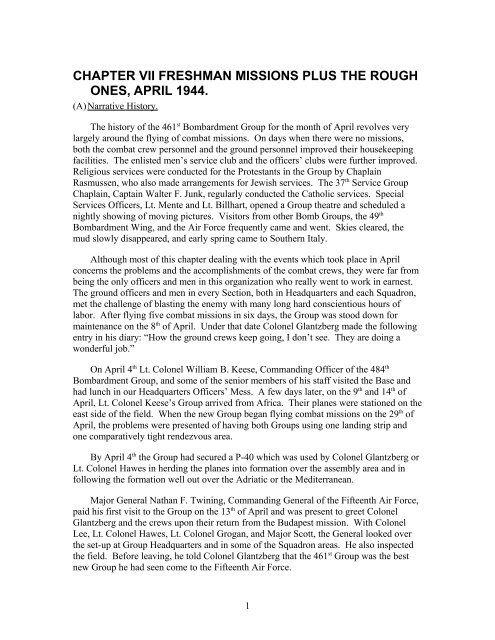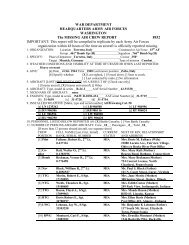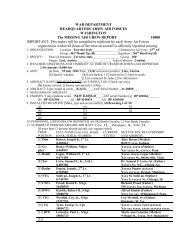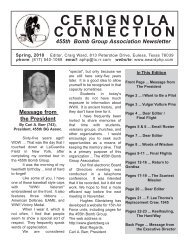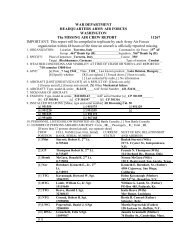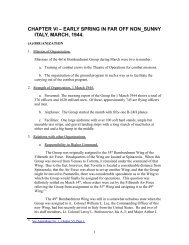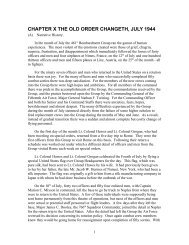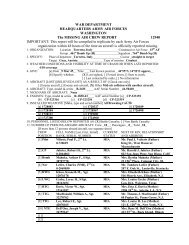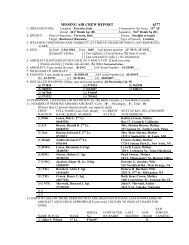chapter vii freshman missions plus the rough ones, april 1944.
chapter vii freshman missions plus the rough ones, april 1944.
chapter vii freshman missions plus the rough ones, april 1944.
You also want an ePaper? Increase the reach of your titles
YUMPU automatically turns print PDFs into web optimized ePapers that Google loves.
CHAPTER VII FRESHMAN MISSIONS PLUS THE ROUGHONES, APRIL <strong>1944.</strong>(A)Narrative History.The history of <strong>the</strong> 461 st Bombardment Group for <strong>the</strong> month of April revolves verylargely around <strong>the</strong> flying of combat <strong>missions</strong>. On days when <strong>the</strong>re were no <strong>missions</strong>,both <strong>the</strong> combat crew personnel and <strong>the</strong> ground personnel improved <strong>the</strong>ir housekeepingfacilities. The enlisted men’s service club and <strong>the</strong> officers’ clubs were fur<strong>the</strong>r improved.Religious services were conducted for <strong>the</strong> Protestants in <strong>the</strong> Group by ChaplainRasmussen, who also made arrangements for Jewish services. The 37 th Service GroupChaplain, Captain Walter F. Junk, regularly conducted <strong>the</strong> Catholic services. SpecialServices Officers, Lt. Mente and Lt. Billhart, opened a Group <strong>the</strong>atre and scheduled anightly showing of moving pictures. Visitors from o<strong>the</strong>r Bomb Groups, <strong>the</strong> 49 thBombardment Wing, and <strong>the</strong> Air Force frequently came and went. Skies cleared, <strong>the</strong>mud slowly disappeared, and early spring came to Sou<strong>the</strong>rn Italy.Although most of this <strong>chapter</strong> dealing with <strong>the</strong> events which took place in Aprilconcerns <strong>the</strong> problems and <strong>the</strong> accomplishments of <strong>the</strong> combat crews, <strong>the</strong>y were far frombeing <strong>the</strong> only officers and men in this organization who really went to work in earnest.The ground officers and men in every Section, both in Headquarters and each Squadron,met <strong>the</strong> challenge of blasting <strong>the</strong> enemy with many long hard conscientious hours oflabor. After flying five combat <strong>missions</strong> in six days, <strong>the</strong> Group was stood down formaintenance on <strong>the</strong> 8 th of April. Under that date Colonel Glantzberg made <strong>the</strong> followingentry in his diary: “How <strong>the</strong> ground crews keep going, I don’t see. They are doing awonderful job.”On April 4 th Lt. Colonel William B. Keese, Commanding Officer of <strong>the</strong> 484 thBombardment Group, and some of <strong>the</strong> senior members of his staff visited <strong>the</strong> Base andhad lunch in our Headquarters Officers’ Mess. A few days later, on <strong>the</strong> 9 th and 14 th ofApril, Lt. Colonel Keese’s Group arrived from Africa. Their planes were stationed on <strong>the</strong>east side of <strong>the</strong> field. When <strong>the</strong> new Group began flying combat <strong>missions</strong> on <strong>the</strong> 29 th ofApril, <strong>the</strong> problems were presented of having both Groups using one landing strip andone comparatively tight rendezvous area.By April 4 th <strong>the</strong> Group had secured a P-40 which was used by Colonel Glantzberg orLt. Colonel Hawes in herding <strong>the</strong> planes into formation over <strong>the</strong> assembly area and infollowing <strong>the</strong> formation well out over <strong>the</strong> Adriatic or <strong>the</strong> Mediterranean.Major General Nathan F. Twining, Commanding General of <strong>the</strong> Fifteenth Air Force,paid his first visit to <strong>the</strong> Group on <strong>the</strong> 13 th of April and was present to greet ColonelGlantzberg and <strong>the</strong> crews upon <strong>the</strong>ir return from <strong>the</strong> Budapest mission. With ColonelLee, Lt. Colonel Hawes, Lt. Colonel Grogan, and Major Scott, <strong>the</strong> General looked over<strong>the</strong> set-up at Group Headquarters and in some of <strong>the</strong> Squadron areas. He also inspected<strong>the</strong> field. Before leaving, he told Colonel Glantzberg that <strong>the</strong> 461 st Group was <strong>the</strong> bestnew Group he had seen come to <strong>the</strong> Fifteenth Air Force.1
From April 17 th to 28 th , Colonel Glantzberg was a patient in <strong>the</strong> 61 st Station Hospitalat Foggia, where he underwent an operation. In <strong>the</strong> Colonel’s absence, Lt. Col. Hawesassumed <strong>the</strong> duties of Commanding Officer. Upon returning from <strong>the</strong> hospital, ColonelGlantzberg flustered <strong>the</strong> members of his Staff into a new and even deeper admiration ofhim by insisting on leading <strong>the</strong> formation to Alessandria on April 30 th .(B) Operations.During <strong>the</strong> month of April <strong>the</strong> Group flew a total of sixteen <strong>missions</strong> to targets,mostly marshalling yards, located in six different countries in Europe: Yugoslavia, Italy,Hungary, Roumania, Austria, and France. There were 508 sorties with 69 early returns,some of which were spares. Tonnage of bombs dropped on targets totaled 874 tons.Claims of enemy fighters were as follows: nine destroyed, four probably destroyed, andone damaged. Six planes and crews were lost to flak.A chart entitled “Analysis of Operations”, a copy of which constitutes part of this<strong>chapter</strong>, depicts <strong>the</strong> breakdown of <strong>the</strong> accomplishments of each Squadron. Ano<strong>the</strong>r chartentitled “Mission Summary”, a copy of which also constitutes part of this <strong>chapter</strong>,presents more of an overall picture of <strong>the</strong> Group’s operations for <strong>the</strong> month of April.MISSIONSMission No. 1, 1 April 1944 – Senigallia R.R. Bridge, Italy (Cancelled)The morning of 1 April 1944 crews were briefed for <strong>the</strong>ir first target. This targetwas a railroad bridge at Senigallia, Italy. Wea<strong>the</strong>r was bad when crews went to <strong>the</strong>irplanes. Flares from <strong>the</strong> tower delayed take-off. Mission finally stood down at 1100o’clock much to <strong>the</strong> disappointment of <strong>the</strong> whole Group.Mission No. 1, 2 April 1944 – Bihac M/Y, YugoslaviaThe first mission flown by <strong>the</strong> Group was that to <strong>the</strong> Bihac Marshalling Yard inYugoslavia. This mission was led, of course, by Colonel Glantzberg. Flight Leader 1 stLt. Joseph N. Donovan was <strong>the</strong> lead pilot with Colonel Glantzberg flying as his co-pilot.Captain Marion M. Pruitt, Group Navigator, was <strong>the</strong> navigator on <strong>the</strong> lead plane with 1 stLt. George V. Leffler, Group Bombardier, as <strong>the</strong> bombardier. The Deputy GroupCommander, Lt. Colonel Philip R. Hawes; <strong>the</strong> Group Operations Officer, Major WilliamBurke; and four Squadron Commanders, Major James B. Knapp, Major Robert E.Applegate, Captain James C. Dooley and Captain Edwin T. Goree flew <strong>the</strong> mission ei<strong>the</strong>rleading a flight or as a Deputy Leader in <strong>the</strong> No. 2 position in “A” Flight of each Section.Two of <strong>the</strong> Squadron Operations Officers, Captain William J. Franklin and 1 st Lt.William H. Tallant, also flew on this mission.The wea<strong>the</strong>r was excellent; <strong>the</strong> bomb load consisted of fragmentation bombs. Allmembers of <strong>the</strong> crews were intensely interested in watching <strong>the</strong>ir first bombs hit a target.As a result, two planes collided over <strong>the</strong> target and were lost. One of those planes waspiloted by 1 st Lt. William H. Zumsteg; <strong>the</strong> o<strong>the</strong>r one by 2 nd Lt. Sidney S. Wilson.2
Intops Summary No. 255, 2 April <strong>1944.</strong> “35 B-24’s of <strong>the</strong> 461 st Bomb Group off on<strong>freshman</strong> mission dropped 61.5 tons of 20 lb. Frags between 1131/1137 hours from19,000/20,000 feet. Five A/C jettisoned 9.5 tons, while 1 A/C dropped 1.8 tons onPianosa Island. Six additional A/C returned early. 4 E/A were seen in target area but<strong>the</strong>re were no encounters and no claims. Two B-24’s were lost due to a collision at <strong>the</strong>rally point. Results reported by crew observations indicate 40 to 60% of bombs in targetarea with heavy smoke in south part of M/Y. Bomb strike photos available giveincomplete coverage of bursts.”Mission No. 2, 3 April 1944 – Drnis M/Y, YugoslaviaThe next day <strong>the</strong> Group was back to Yugoslavia again on ano<strong>the</strong>r of its <strong>freshman</strong><strong>missions</strong>. This time <strong>the</strong> target was <strong>the</strong> marshalling yard at Drnis. Lt. Colonel Hawes was<strong>the</strong> formation leader while Colonel Glantzberg flew as a Second Section Leader. Flyingin <strong>the</strong> lead plane with Lt. Colonel Hawes were <strong>the</strong> pilot, Flight Leader 1 st Lt. Floyd W.Woodard; Captain Pruitt; and Lt. Leffler. Again Major Burke, <strong>the</strong> four SquadronCommanders, and <strong>the</strong> two Squadron Operations Officers who had not flown <strong>the</strong> previousday: Captain William J. Bock and Captain David P. McQuillan also flew this mission.The air speed flown by <strong>the</strong> lead plane was too slow with <strong>the</strong> result that <strong>the</strong> formation wasbadly spread.The day was hazy and Group leaders had difficulty in identifying <strong>the</strong> target against<strong>the</strong> tan background of early spring. The mission was not as successful as had been <strong>the</strong>first one, and <strong>the</strong> crew members began to realize that targets were not easy to identify andhit.Mission No. 3, 5 April 1944 – Nis M/Y, YugoslaviaThis mission was led by Major Robert E. Applegate, 765 th Squadron Commander.Colonel Glantzberg flew <strong>the</strong> deputy lead position. The Deputy Group Commander, <strong>the</strong>Group Operations Officer, and all <strong>the</strong> Squadron Commanders also flew this mission.To <strong>the</strong> haze that had been experienced on <strong>the</strong> second mission was added 8/10undercast for this third mission. As a result of <strong>the</strong> haze, <strong>the</strong> undercast, and <strong>the</strong> tanbackground on <strong>the</strong> ground, <strong>the</strong> target was missed completely. For <strong>the</strong> first and only timeduring <strong>the</strong> month no pictures of <strong>the</strong> bombing were obtained.The formation was <strong>the</strong> best thus far flown by <strong>the</strong> Group. Several mistakes, however,were made. The Group failed a 360º circle and let down to bomb below <strong>the</strong> overcast; itfailed to get on <strong>the</strong> step before <strong>the</strong> bomb run; it failed to cover a cripple on <strong>the</strong> way home;and it also failed to get under <strong>the</strong> overcast for <strong>the</strong> return trip home across <strong>the</strong> Adriatic.Mission No. 4, 6 April 1944 – Zagreb A/D, YugoslaviaThe 764 th Squadron Commander, Captain Edwin T. Goree, did an outstanding job inleading this mission. The lead pilot, 2 nd Lt. James O. Bean, his bomardier; 2 nd Lt. GeaogeB. Cran; and <strong>the</strong> Squadron Navigator, 1 st Lt. Earl M. DeWitt were <strong>the</strong> officers on <strong>the</strong> lead3
plane. For <strong>the</strong> fourth day in succession <strong>the</strong> <strong>freshman</strong> mission took <strong>the</strong> Group toYugoslavia.The mission was ano<strong>the</strong>r fragmentation mission; this time to <strong>the</strong> north end of <strong>the</strong>airdrome at Zagreb. Nine-tenths cloud coverage obscured <strong>the</strong> target and only fifteen of<strong>the</strong> thirty-one planes over <strong>the</strong> target dropped <strong>the</strong>ir bombs. This was <strong>the</strong> first mission onwhich <strong>the</strong> Group had fighter escort and was its first encounter with enemy fighters. Theattack was made by six ME-109s and by nine FW-190s. One enemy plane was shotdown. This fighter was claimed by S/Sgt. Melborn Dale Williamson <strong>the</strong> top turret gunneron a plane in <strong>the</strong> 765 th Squadron.The plane flown by 2 nd Lt. John K. Specht and Major Robert E. Applegate, which didnot drop its bombs on <strong>the</strong> target, developed a fire in <strong>the</strong> bomb bay that led to an explosionwhen <strong>the</strong> bombs were jettisoned over <strong>the</strong> Adriatic returning from <strong>the</strong> target. Threemembers of <strong>the</strong> crew left <strong>the</strong> plane and were lost. They were: <strong>the</strong> bombardier, 2 nd Lt.William S. Sullivan; <strong>the</strong> navigator, 2 nd Lt. Harold E. Milne; and <strong>the</strong> nose turret gunner,Sgt. John J. Marszalkiewics. Near <strong>the</strong> Base <strong>the</strong> seven remaining members of <strong>the</strong> crewabandoned <strong>the</strong> plane and parachuted safely to earth. Crew members were rapidlylearning that combat <strong>missions</strong> are dangerous. As a result of this mission all crewmembers developed a deep-seated and persistent dislike for fragmentation bombs.The Commanding Officer, <strong>the</strong> Deputy Group Commander, <strong>the</strong> Group OperationsOfficer, and <strong>the</strong> four Squadron Commanders, and two of <strong>the</strong> Squadron OperationsOfficers all flew this mission.Mission No. 5, 7 April 1944 – Ferrara M/Y, ItalyFreshman mission days were now behind. Instead of flying individual <strong>missions</strong>, <strong>the</strong>Group was assigned for <strong>the</strong> first time to fly Wing formation. This was <strong>the</strong> first of several<strong>missions</strong> to be flown with <strong>the</strong> Groups with <strong>the</strong> 55 th Wing.Beginning with this mission <strong>the</strong> Group began to curtail on <strong>the</strong> number of executivepilots flying every mission. As a result of <strong>the</strong> experiences gained in <strong>the</strong> former <strong>missions</strong>,Colonel Glantzberg ordered that an exceptionally competent bombardier or navigatorshould ride in <strong>the</strong> nose turret of <strong>the</strong> lead ship to assist in pilotage. 1 st Lt. Stiles, 766 thSquadron Bombardier, flew this mission in that capacity.Although <strong>the</strong> crews did not sense it when <strong>the</strong>y were briefed for <strong>the</strong>ir fifth mission onGood Friday morning, <strong>the</strong>ir <strong>missions</strong> were getting tougher. Their target was <strong>the</strong> first onewhich <strong>the</strong> Group had been assigned in Italy, that of <strong>the</strong> South Marshalling Yard, Ferrara.Colonel Glantzberg, Lt. Donovan, Captain Pruitt, and Lt. Leffler, who had led <strong>the</strong> firstmission, were back again in <strong>the</strong> lead. Again enemy aircraft were seen but notencountered. The pilots all did a superior job of formation flying on this mission. Over<strong>the</strong> target <strong>the</strong> Group experienced intense, aimed, and extremely accurate heavy flak for<strong>the</strong> first time. Despite this new shocking experience <strong>the</strong> crews did an outstanding job.Having seen enemy fighters for <strong>the</strong> second time, having been hit hard over <strong>the</strong> target byenemy anti-aircraft guns, and having really covered <strong>the</strong> target with a beautiful pattern of4
ombing, <strong>the</strong> crew members began to believe <strong>the</strong>y were veterans. There was no stoppingthis Group after confidence built in all personnel by <strong>the</strong> success of this mission.Intops Summary No. 260, 7 April <strong>1944.</strong> “33 B-24’s of <strong>the</strong> 461 st Bomb Group weredispatched. There were no early returns and all bombed primary dropping 66 tons of 500lb GP bombs at 1310 hours from 21,000 feet. 5 S/E aircraft and 4 Ju-88s were seen in <strong>the</strong>distance 15 miles S.E. of target. Flak at <strong>the</strong> target was intense, accurate, heavy, aimedtype. There were no losses. Photo reconnaissance photos show bombing exceedinglywell concentrated on <strong>the</strong> target area, and in addition to hits which have totally blocked <strong>the</strong>yards and inflicted much damage on rolling stock, several damaging hits have beenscored on industrial buildings, including <strong>the</strong> reported ball-bearing plant West of <strong>the</strong> yard.The main weight of <strong>the</strong> bombs fell on South end of <strong>the</strong> M/Y and <strong>the</strong> loco depot,damaging many of <strong>the</strong> approximately 200 cars present and at least two locos. Hits werescored on <strong>the</strong> immediate approach to <strong>the</strong> South end of <strong>the</strong> river railroad bridge whichcompletely blocks <strong>the</strong> yard; on <strong>the</strong> sugar refinery, flour mill, goods shed West of <strong>the</strong>main line tracks; and two large buildings just to <strong>the</strong> East of <strong>the</strong> yard. Observation ofo<strong>the</strong>r evidenced damage is hampered by <strong>the</strong> smoke from fires started in <strong>the</strong> area.”MEDITERRANEAN ALLIED PHOTORECONNAISANCE WING.SECRET10 th April 1944INTERPRETATION REPORT No. D.B. 43. ITALY.683 Squadron Sortie P.177, dated 10 th April 1944 mean time 1600 hours shows:Ferrara M/Y.Attacked by 33 B-24s on 7 th April <strong>1944.</strong>Last report AI/219, dated 14 th February <strong>1944.</strong>Th<strong>rough</strong> lines are open. The main weight of <strong>the</strong> attack has fallen on <strong>the</strong> Sou<strong>the</strong>rnend of <strong>the</strong> M/Yd, and on industrial plant in <strong>the</strong> vicinity. Some clearance andrepairs are noted to areas in <strong>the</strong> town previously damaged, and to <strong>the</strong> TransformerStation, to <strong>the</strong> South, and <strong>the</strong> Canepificio Minificio Milano Hemp Factory,northwest of <strong>the</strong> M/Yd.(1) Soc. E. Sercizio Molini Flour Mill smoldering at <strong>the</strong> time of photography andmore than three quarters destroyed.(2) At least three hits on <strong>the</strong> Sou<strong>the</strong>rn approach to <strong>the</strong> R/R bridge have cutth<strong>rough</strong> tracks to BOLOGNA and branch lines to Poggio Rusco, and PortoMaggiore, but two lines have been repaired and repairs still in progress on twoo<strong>the</strong>rs. Road bridge to <strong>the</strong> East almost severed.(3) Damage to three out-buildings of Canepificio Sinz Hemp Mill, one buildingone quarter destroyed, and two half destroyed by fire and H.E.(4) Fur<strong>the</strong>r damage, or clearance to North side of main building of <strong>the</strong> C.S. HempMill. (See also 3)(5) Additional damage to buildings in <strong>the</strong> Zuccherificio Bonora Sugar Refinery,which was already largely destroyed.5
(6) Several hits in M/Yd cutting tracks and wrecking rolling stock, but th<strong>rough</strong>lines have been opened, and a train is seen moving south at time ofphotography.(7) Direct hit cutting tracks into car shops.(8) Moderately large R/R buildings fur<strong>the</strong>r damaged and partially demolished.(9) Heavy damage to main building of factory believed to be <strong>the</strong> Fratelli ZanziAero Engine Valve Factory. Three out if six large bays with curved roofshave been completely destroyed. Construction activity just E. of here.(10) Direct hit on main building of <strong>the</strong> I.M.I. Ball Bearing factory.(11) Unidentified ‘L’ shaped building half destroyed.(12) Clearance of previously damaged area in Canepificio Linificio MilanoHemp Factory. (Not on print distributed)(13) Industrial Siding probably cut and repaired.Annotated Print Distributed:Prints:Comparative:COMMENDATION40774090-4092, 4076-4078P.94, 3110-3113, 4093-4098As a result of this highly successful mission, <strong>the</strong> following commendation wasreceived in <strong>the</strong> form of a TWX message from Major General Nathan F. Twining,Commanding General of <strong>the</strong> Fifteenth Air Force:“FROM: TWINING, CG 15AF“TO: CO 461 BG“FOR THE EXCELLENT BOMBING PATTERN ON ATTACKOF FERRARA, ITALY, MARSHALLING YARDS AS EVIDENCEDBY STRIKE PHOTOS, I DESIRE TO SEND ‘WELL DONE’ TO THE461 GROUP.”Missions No. 6: 8, 9, 11 April <strong>1944.</strong>On <strong>the</strong> 8th of April and again on <strong>the</strong> 9th, <strong>missions</strong> were briefed for <strong>the</strong> marshallingyard at Zagreb, Yugoslavia. Both <strong>missions</strong> were stood down. On 11 April 1944 stillano<strong>the</strong>r mission was stood down. Target for that day was to have been <strong>the</strong> M/Y atBologna, Italy.Mission No. 6, 12 April 1944 – Zagreb M/Y, YugoslaviaAfter four days of inactivity, Mission No. 6 was flown on 12 April. The target was<strong>the</strong> marshalling yard at Zagreb. Despite a four-tenths undercast and much flak, <strong>the</strong> crewsdid an excellent job.Mission No. 7, 13 April 1944 – Duna (Tokol) A/C Factory, Budapest, Hungary.6
For <strong>the</strong> seventh mission, which was against <strong>the</strong> Duna Tokol A/C ComponentsFactory at Budapest, RDX bombs were used for <strong>the</strong> first time by this Group. MajorBurke flew as Group leader for <strong>the</strong> first time. On this mission a total of 58 enemy aircraftwere seen. Several encounters were experienced, three enemy planes were destroyed andthree more claimed as probable. Twin-engine enemy airplanes fired rockets at <strong>the</strong>formation. Single engine enemy airplanes flew parallel with <strong>the</strong> Group at a safe distanceand radioed headings, altitude, and air speed to <strong>the</strong>ir ground installations. Flak over <strong>the</strong>target was intense, accurate, and heavy. Two bombers were lost over <strong>the</strong> target. 1 st Lt.Charles W. Bauman, flying <strong>the</strong> deputy lead position in “A” Flight of <strong>the</strong> second Section,had part of a wing shot off by flak. His plane fell into <strong>the</strong> plane in <strong>the</strong> number 4 positionof <strong>the</strong> same flight, which was piloted by 2 nd Lt. Paul S. Mowery. A third plane flown by2 nd Lt. Kay B. Steele, which had come off <strong>the</strong> target with <strong>the</strong> formation, failed to return to<strong>the</strong> Base. Colonel Glantzberg, who was flying as co-pilot in a plane in <strong>the</strong> secondSection, led a small formation of planes in chasing attacking Ju-88s away from thisdamaged plane. He was unable, however, to stay with <strong>the</strong> plane because of an undercast.Fifteen planes were damaged over this target.Again <strong>the</strong> Group turned in an excellent mission by dropping 45 per cent of its bombswithin 1,000 feet of <strong>the</strong> briefed aiming point on a comparatively rectangular building wellhidden in woods.COMMENDATIONFrom General Twining on <strong>the</strong> following day came <strong>the</strong> following TWX th<strong>rough</strong>channels:“FROM: TWINING CITE FAF ABLE 16“TO: CO 461 ST BOMB GROUP“IT IS DESIRED THAT YOU EXPRESS MY APPRECIATIONTO ALL PARTICIPATING PERSONNEL IN YESTERDAY’SCOUNTER AIR FORCE OPERATIONS FOR DOING ANESPECIALLY FINE JOB. THE 460, 461, AND 483 BOMB GROUPSDID ESPECIALLY GOOD BOMBING ALTHOUGH RELATIVELYINEXPERIENCED. THE AGGRESSIVENESS OF THE FIGHTERUNITS AND THEIR EXCELLENT ESCORT WORK CONTRIBUTEDIMMEASURABLY TO THE SUCCESS OF THIS OUTSTANDINGOPERATION.”“PS: KEEP UP THE GOOD WORK.”THE 49 TH WING ADDS ITS PROUD COMMENDATIONS TOTHE COMMANDING GENERAL’S EVALUATION OF YOURWORK.The following TWX was also received after this mission:7
“FROM: LEE CO 49 TH BOMB WING“TO: COMMANDING OFFICER, 451 ST 461 ST 484 TH BOMB GROUPSAPO 520“THE FOLLOWING MESSAGE FROM THE FIFTEENTH AIRFORCE IS QUOTED FOR YOUR INFORMATION. CITE FAF BAKER13 – I AM HAPPY TO PASS ON THE FOLLOWING MESSAGERECEIVED FROM THE COMMANDING GENERAL, EIGHT AIRFORCE. ‘THE EIGHT AIR FORCE JOINS ME INCONGRATULATIONS ON YOUR RECENT OPERATIONS. WE OFTHE EIGHT FULLY APPRECIATE THE EFFECT OF THESEOPERATIONS TOWARD ACCOMPLISHING OUR JOINTMISSION.’”Mission No. 8, 14 April 1944 – Chitila M/Y at Bucharest, Roumania (Cancelled)Mission No. 8, 15 April 1944 - Chitila M/Y at Bucharest, RoumaniaWith Mission No. 8 <strong>the</strong> Group was off on its first mission to Roumania. Badwea<strong>the</strong>r built up over Yugoslavia and <strong>the</strong>re was nine-tenths cloud coverage in <strong>the</strong> targetarea. Bombs were dropped, but <strong>the</strong> results were unobserved. Twenty enemy aircraftwere seen but <strong>the</strong>re were no encounters.Mission No. 9, 16 April 1944 – Belgrade Zemun A/D, YugoslaviaThe primary target for this mission was <strong>the</strong> Brasov Airdrome in Roumania. Badwea<strong>the</strong>r experienced <strong>the</strong> day previous on <strong>the</strong> Bucharest Mission had moved westward andbuilt up to over 20,000 feet. Nineteen of <strong>the</strong> thirty-four planes to take off lost <strong>the</strong>formation in <strong>the</strong> clouds over Yugoslavia and returned to <strong>the</strong> Base. Fourteen o<strong>the</strong>rsindividually worked <strong>the</strong>ir way to <strong>the</strong> top of cloud formations and reformed on ColonelGlantzberg who chose <strong>the</strong> last resort target, Belgrade Zemun A/D in Yugoslavia, as histarget.Fragmentation bombs were dropped with unobserved results th<strong>rough</strong> haze and sixtenthscloud coverage. Again twenty enemy aircraft were seen without any encounters.Half of <strong>the</strong> planes over <strong>the</strong> target were hit by flak and one was lost th<strong>rough</strong> flak over <strong>the</strong>target. On this plane, piloted by 1 st Lt. Floyd W. Woodard, were <strong>the</strong> members of one of<strong>the</strong> four original “model crews”.Mission No. 10, 17 April 1944 – Belgrade Zemun A/D, YugoslaviaThe primary target for this mission was <strong>the</strong> last resort target of yesterday. This time<strong>the</strong> target was completely obscured by clouds and no fragmentation bombs were dropped.This was Major Knapp’s first mission as Group leader.8
Mission No. 11, 20 April 1944 – Tagliamento Casarsa RR Bridge, ItalyReconnaissance photography having revealed that <strong>the</strong> enemy had partially repaired<strong>the</strong> damage this Group had done to <strong>the</strong> South Marshalling Yard at Ferrara, Italy on April7 th , <strong>the</strong> Group was reassigned to hit ano<strong>the</strong>r section of <strong>the</strong> same target. Because of badwea<strong>the</strong>r over <strong>the</strong> primary target <strong>the</strong> Group went on to bomb <strong>the</strong> first alternative, <strong>the</strong>Tagliamento Casarsa Railroad Bridge at <strong>the</strong> head of <strong>the</strong> Adriatic in Italy. This was <strong>the</strong>first attempt of <strong>the</strong> Group to bomb a bridge. The cloud coverage was seven-tenths.Coming down <strong>the</strong> river and hitting <strong>the</strong> target at right angles, <strong>the</strong> Group scored several hitson both <strong>the</strong> railroad bridge and <strong>the</strong> highway bridge beyond it. Fifteen per cent of <strong>the</strong>bombs dropped were plotted within a 1,000 feet of <strong>the</strong> briefed aiming point. Thirteenenemy aircraft seen by <strong>the</strong> Group made no passes at <strong>the</strong> formation.Mission No. 12, 21 April 1944 – Chitila M/Y at Bucharest, RoumaniaAgain <strong>the</strong> target was <strong>the</strong> Chitila M/Y, Bucharest, Roumania, and again <strong>the</strong> wea<strong>the</strong>rwas bad. A solid undercast prevented bombing with <strong>the</strong> result that all bombs werejettisoned in <strong>the</strong> Adriatic. Forty enemy aircraft were seen, several were encountered, andone was shot down. A nose gunner, Sgt. W.G. Rollins, became <strong>the</strong> first casualty on acrew when his face was cut by shell casings from ano<strong>the</strong>r plane.Mission No. 13, 23 April 1944 – Bad Voslau A/D, AustriaWhen <strong>the</strong> crew members learned at briefing that <strong>the</strong>y were to attack <strong>the</strong>ir first targetin Vienna Area, <strong>the</strong>y fully realized that <strong>the</strong>y were now in <strong>the</strong> big time. Before our Grouphit its target <strong>the</strong> 304 th Wing had performed an outstanding job in practically demolishing<strong>the</strong> buildings at <strong>the</strong> Airdrome. Uncovering <strong>the</strong> three flights of each Section inapproaching <strong>the</strong> target, <strong>the</strong> Group, led for <strong>the</strong> first time by Captain Dooley, completelysprayed <strong>the</strong> landing field with fragmentation bombs. The bombing pattern was one ofperfection. The returning crews doubted if it would ever be necessary to return again tothat target. Several encounters were had with twenty-three enemy fighters, two of whichwere claimed as probably destroyed. Fourteen planes over <strong>the</strong> target were hard hit byflak.There were two casualties as a result of this mission: Bombardier, F/O R.B. Stewart,and a ball turret gunner, Sgt. P.N. Godino, both on 2 nd Lt. G. Fulks’ crew. Each was hitin <strong>the</strong> foot by flak.COMMENDATION“FROM: OPERATIONS OFFICE 49 TH BOMB WING“TO: COMMANDING OFFICERS, 451 ST , 461 ST , 484 TH BOMB GROUPS“THE BOMBING OF BAD VOSLAU, 23 APRIL, BY THE 49 THWING WAS EXCELLENT. PLEASE PASS TO ALL PARTICIPATINGMY COMMENDATION FOR A JOB WELL DONE. COL. LEEDESIRES TO EXPRESS APPRECIATION FOR A JOB WELL DONE.”9
Mission No. 14, 24 April 1944 – Chitila M/Y, Bucharest, Roumania“LEE”For <strong>the</strong> third time during <strong>the</strong> month <strong>the</strong> Group went to Chitila Marshalling Yard atBucharest, Roumania. This time <strong>the</strong> wea<strong>the</strong>r was CAVU with haze. The target waspicked up by <strong>the</strong> lead plane, but unfortunately a bomb rack malfunction temporarily heldup <strong>the</strong> bombs in <strong>the</strong> lead plane, which overshot <strong>the</strong> target. This was also true of most of<strong>the</strong> planes in <strong>the</strong> first attack unit who were dropping on <strong>the</strong> section leader. The secondSection saved <strong>the</strong> day for <strong>the</strong> Group by getting 11 per cent of all <strong>the</strong> bombs dropped by<strong>the</strong> Group on <strong>the</strong> briefed aiming point. The flak was intense and heavy, but inaccurate.Of <strong>the</strong> twenty-five enemy fighters seen, several were encountered, one was destroyed,and one was damaged.Mission No. 15, 25 April 1944 – Nord A/D, Wiener Neustadt, Austria(Cancelled)Mission No. 15, 26 April 1944 – Wollerdorf A/D, Wiener Neustadt, Austria(Cancelled)Mission No. 15, 27 April 1944 – Wollerdorf A/D, Wiener Neustadt, Austria(Cancelled)Mission No. 15, 29 April 1944 – Submarine Pens, Toulon Harbor, FranceThis mission took <strong>the</strong> Group on its first trip to France and to a target in <strong>the</strong> sixthcountry of Europe that <strong>the</strong> Group bombed during <strong>the</strong> month of April. This was <strong>the</strong> firstmission on which <strong>the</strong> 451 st , <strong>the</strong> 461 st and <strong>the</strong> 484 th flew as <strong>the</strong> Groups of <strong>the</strong> 49 thBombardment Wing. The mission provided ano<strong>the</strong>r new experience for <strong>the</strong> Group in that<strong>the</strong> target had been previously obscured by a perfect smoke screen from smudge potssituated both on shore and on ships in <strong>the</strong> harbor. For <strong>the</strong> first time <strong>the</strong> Group used1,000-pound bombs. Results were unobserved, but no bombs were believed to have hit<strong>the</strong> target. The Group Bombardier, Captain Leffler, who was <strong>the</strong> lead bombardier on <strong>the</strong>mission and who had already turned in five successful <strong>missions</strong> during <strong>the</strong> month, bothlaughed at and cursed <strong>the</strong> clever Kraut.Mission No. 16, 30 April 1944 – Alexandria M/Y, ItalyFor <strong>the</strong> last mission of <strong>the</strong> month <strong>the</strong> Group was back to Italy and to its marshallingyard targets. The target, a large one, was hard hit, but <strong>the</strong> bombs were scattered across along area. Colonel Glantzberg was most unhappy when <strong>the</strong> pictures showed that only 17per cent of <strong>the</strong> bombs had hit <strong>the</strong> aiming point of this easily identified target, especiallysince <strong>the</strong> wea<strong>the</strong>r was CAVU, and <strong>the</strong>re were nei<strong>the</strong>r flak nor fighters to interfere with<strong>the</strong> bombing.MISSING IN ACTIONRank Name Home Town Mission10
Date Target1 st Lt. William H. Zumsteg Burlinggame, Cal, 4/2/44 Bihac2 nd Lt. John C. Fuller Jr. Lumberton, N.C. 4/2/44 Bihac2 nd Lt. George M. Felbar Irvington, N.J. 4/2/44 Bihac2 nd Lt. Joseph J. Repko Freeland, Pa. 4/2/44 BihacM/Sgt. Oscar R. Ives Diagonal, Ia. 4/2/44 BihacS/Sgt. Woodrow P. Clayton Houston, Tex. 4/2/44 BihacS/Sgt. Antonio P. Lerma Laredo, Tex. 4/2/44 BihacS/Sgt. Andrew J. Allocco Rochester, N.Y. 4/2/44 BihacS/Sgt. Alvin J. Kadlecek Sugar Island, Tex. 4/2/44 Bihac2 nd Lt. Sidney S. Wilson Buffalo, N.Y. 4/2/44 Bihac2 nd Lt. Emil L. Whitney Kooskia, Idaho 4/2/44 Bihac2 nd Lt. Harlan P. Ross Maywood, N.J. 4/2/44 Bihac2 nd Lt. Joseph W. Loftus Jr. Burlington, Cal. 4/2/44 BihacT/Sgt. Irving G. Wallace Wyoming, N.Y. 4/2/44 BihacS/Sgt. Gerald Goldstein Brooklyn, N.Y. 4/2/44 BihacSgt. Edward G. Ulrich Fort Lee, N.J. 4/2/44 BihacSgt. Dale V. Fine Drumright, Okla. 4/2/44 BihacSgt. Homer D. Childs Southington, Conn. 4/2/44 BihacSgt. Clifford A. McCoy Campton, Mo. 4/2/44 Bihac2 nd Lt. Harold E. Milne Barre, Vt. 4/6/44 Zagreb2 nd Lt. William S. Sullivan Los Angeles, Cal. 4/6/44 ZagrebSgt. John J. Marszalkiewicz Baltimore, Md. 4/6/44 Zagreb2 nd Lt. Kay B. Steale Idaho Falls, Idaho 4/13/44 Budapest2 nd Lt. Ralph M. McKinney Aurora, Illinois 4/13/44 Budapest2 nd Lt. Charles M. Smith Jr. Idaho Falls, Idaho 4/13/44 Budapest2 nd Lt. Jack R. Severns Long Beach, Cal. 4/13/44 BudapestCpl. Charles A. Humphress Indianapolis, Ind. 4/13/44 BudapestS/Sgt. John F. Reynolds Madison, Wis. 4/13/44 BudapestSgt. Even G. Medellin Hebbronville, Tex. 4/13/44 BudapestS/Sgt. Richard G. Lyke Edmonds, Wash. 4/13/44 BudapestSgt. Stanley A. Kosierowski Brooklyn, N.Y. 4/13/44 BudapestSgt. Merle A. Troup Washington, D.C. 4/13/44 Budapest2 nd Lt. Philip J. Caroselli Jersey City, N.J. 4/13/44 Budapest1 st Lt. Charles W. Bauman Dallas, Tex. 4/13/44 Budapest2 nd Lt. David N. Riker Oblong, Tex. 4/13/44 Budapest2 nd Lt. Edward F. Zabriskie Newark, N.J. 4/13/44 Budapest2 nd Lt. Frank E. Ritacco Worcester, Mass. 4/13/44 BudapestT/Sgt. Alfred G. Brindle Providence, R.I. 4/13/44 BudapestS/Sgt. Leopoldo Velarde Velarde, N.M. 4/13/44 BudapestT/Sgt. Michael Ventresca Waterbury, Conn. 4/13/44 BudapestS/Sgt. Edward C. Bross Philadelphia, Pa. 4/13/44 Budapest11
Sgt. John H. Householder Canton, Ohio 4/24/44 BucharestSgt. Edward P. Ward Bayonne, N.J. 4/24/44 Bucharest(C) Photo SectionThe enclosed photographs accompany this History for <strong>the</strong> month.(D)Special Accountsa. Awards and Decorations.HEADQUARTERS461 st Bombardment Group (H) AAFSPECIAL ORDERSAPO 520, c/o PostmasterNUMBER 12New York, New York,15 April <strong>1944.</strong>9. Under <strong>the</strong> provisions of WD Circular 27 (1944) <strong>the</strong> following personnel, 461 stBomb Grp, are awarded <strong>the</strong> American Defense Service Medal. The proper entry will bemade in WD AGO Forms 66-1 and 24:HQ 461 ST BOMB GPLT COL EDWIN W. GROGAN 0274185 LT COL PHILIP R. HAWES 021220MAJ R FOSTER SCOTT 0237137 MAJ WILLIAM (NMI) BURKE 0409947MAJ CHARLES J. DEISHLEY 0393951 CAPT JOHN A. WAGENER 0434395CAPT HENRY M. HUDSON 0483850 CAPT MARION M. PRUITT 0356129CAPT WALTER G. MITTON 0269470 1 ST LT GEORGE V. LEFFLER 020437621 ST LT LOUIS C. PFISTER 0650154 2 ND LT CHARLES S. BILLHART 05739422 ND LT JAMES C. CLARK 0571272 CWO FRED C. MEDAU W2123965M SGT HEWITT (NMI) CALLENDER 6552830 T SGT RAY L. SEATON 16004535T SGT ARMANDO B. DOMINGUEZ 19061716 S SGT LLOYD F. BELL 14047932SGT BENJAMIN R. GREGORY 18044254 PVT CARL L. SHIPP 37015999SQUADRON COMMANDERSMAJ JAMES B. KNAPP 021890 CO, 767 th Bomb SquadronMAJ ROBERT E. APPLEGATE 022933 CO, 765 th Bomb SquadronCAPT JAMES C. DOOLEY 0431130 CO, 766 th Bomb SquadronCAPT EDWIN T. GOREE 0724610 CO, 764 th Bomb SquadronBy order of Colonel GLANTZBERG:OFFICIAL:/s/ R. FOSTER SCOTTR. FOSTER SCOTTMajor, Air Corps,Adjutant.R. FOSTER SCOTT,Major, Air Corps,Adjutant.13
GENERAL ORDERSNUMBER 239HEADQUARTERSFIFTEENTH AIR FORCEAPO 52019 April <strong>1944.</strong>SECTION XII – AWARDS OF THE DISTINGUISHED FLYING CROSSJOSEPH N. DONOVAN, 0-666158, First Lieutenant, Air Corps, 766 th BombardmentSquadron, 461 st Bombardment Group, United States Army. For extraordinaryachievement while participating in aerial flight. On 7 April 1944, Lieutenant Donovanwas <strong>the</strong> lead pilot of a group of B-24 type aircraft on a mission to bomb an enemy railcenter in Italy. Because of his skill and judgment as a leader, Lieutenant Donovan waschosen to lead <strong>the</strong> group on this vitally important mission. The target was obscured byhaze, making perception extremely difficult, and, an intense concentration of accurateheavy flak, which damaged several planes in <strong>the</strong> formation, was encountered on <strong>the</strong>bombing run. Despite <strong>the</strong> heavy opposition and grave danger, he concentrated onmaintaining his course, enabling his bombardier to make a perfect bomb run on <strong>the</strong>target. Due to <strong>the</strong> excellent formation flown and <strong>the</strong> faultless bomb pattern obtained,grave damage was inflicted on enemy equipment, material, and installations. LieutenantDonovan’s rapid development of tactical ability, his consummate flying skill and superiorleadership has reflected great credit upon himself and <strong>the</strong> Armed Forces of <strong>the</strong> UnitedStates of America. Residence at appointment: San Luis Ptotsi, MexicoGEORGE V. LEFFLER, 0-2043762, First Lieutenant, Air Corps, Headquarters, 461 stBombardment Group, United States Army. For extraordinary achievement whileparticipating in aerial flight in <strong>the</strong> Mediterranean Theatre of Operations as groupbombardier of B-24 type aircraft. As lead bombardier during a high altitude daylightbombingmission over an enemy rail center in Italy on 7 April 1944, Lieutenant Lefflerfound <strong>the</strong> target obscured by haze, making accurate bombing extremely difficult.Directing <strong>the</strong> coordination of <strong>the</strong> entire formation with superb craftsmanship andconcentrating on his task, despite an intense barrage of heavy and accurate enemy antiaircraftfire, he made a perfect bombing run on <strong>the</strong> target, thus enabling <strong>the</strong> entireformation to drop <strong>the</strong>ir bombs with exceptionally successful results. Because of <strong>the</strong>precision and leadership so ably displayed by Lieutenant Leffler in his capacity of greatresponsibility as lead bombardier on this and o<strong>the</strong>r combat <strong>missions</strong> against <strong>the</strong> enemy,he has reflected great credit upon himself and <strong>the</strong> Air Forces of <strong>the</strong> United States ofAmerica. Residence at appointment: Madison, Wisconsin.OFFICIAL:By order of Major General Twining:/s/ J.M. IVINSJ.M. IVINSR.K. Taylor,Colonel, GSC,Chief of Staff.14
GENERAL ORDERSLieutenant Colonel, AGD,Adjutant General.HEADQUARTERSFIFTEENTH AIR FORCEAPO 52030 April <strong>1944.</strong>NUMBER 314SECTION V – AWARDS OF THE DISTINGUISHED FLYING CROSS AND/OROAK LEAF CLUSTER FOR THE DESTINGUISHED FLYING CROSSUnder <strong>the</strong> provisions of AR 600-45, as amended, and pursuant to authority containedin Circular No. 26, Headquarters NATOUSA, 6 March 1944, <strong>the</strong> Distinguished FlyingCross and/or Oak Leaf Cluster for <strong>the</strong> Distinguished Flying Cross, in <strong>the</strong> categories aslisted, is awarded <strong>the</strong> following named officers, Air Corps, United States Army, residenceas indicated, with <strong>the</strong> following citation:For extraordinary achievement while participating in aerial flight in MediterraneanTheatre of Operations as pilot, co-pilot, navigator and bombardier of a B-24 type aircraft.On 13 April 1944, while leading <strong>the</strong>ir group on a vitally important bombing missionagainst an enemy aircraft factory in Hungary, severe and intense enemy opposition wasencountered in <strong>the</strong> target area that seriously damaged <strong>the</strong>ir plane, and rendered one (1)engine inoperative. Despite <strong>the</strong> fact that adverse wea<strong>the</strong>r conditions had partiallyobscured <strong>the</strong> objective and <strong>the</strong>ir aircraft was practically unairworthy, <strong>the</strong>se crew membersknowing <strong>the</strong> importance of <strong>the</strong>ir heavy responsibility, continued th<strong>rough</strong> to <strong>the</strong> target andled <strong>the</strong> group on a flawless bombing run which caused utter demolition of vital enemyinstallations, factories, and material. Continuing on from <strong>the</strong> target area th<strong>rough</strong> averitable hail of enemy anti-aircraft fire during which <strong>the</strong>ir plane was fur<strong>the</strong>r damaged,<strong>the</strong>y led <strong>the</strong>ir group formation safely home without loss. By <strong>the</strong>ir exceptionalprofessional skill, outstanding leadership and intense devotion to duty, <strong>the</strong>se officers,th<strong>rough</strong> <strong>the</strong>ir cool efficiency in completing a successful and important mission againstgreat odds, upheld <strong>the</strong> highest tradition of <strong>the</strong> Military Service, <strong>the</strong>reby reflecting greatcredit upon <strong>the</strong>mselves and <strong>the</strong> Armed Forces of <strong>the</strong> United States of AmericaDISTINGUISHED FLYING CROSSWILLIAM (NMI) BURKE, 0-409947, Major, Headquarters, 461 st BombardmentGroup. Residence at appointment: Orwigsburg, Pennsylvania.MARION M. PRUITT, 0-356129, Captain, Headquarters, 461 st BombardmentGroup. Residence at appointment: Greenville, Texas.MARION C. MIXSON, 0-382635, first Lieutenant, Headquarters, 461 stBombardment Group. Residence at appointment: Charleston, South CarolinaFIRST (1 st ) OAK LEAF CLUSTER (BRONZE) FOR THE DISTINGUISHEDFLYING CROSS15
GEORGE V. LEFFLER, 0-2043762, First Lieutenant, Headquarters, 461 stBombardment Group. Residence at appointment: Madison, Wisconsin.By order of Major General Twining:OFFICIAL:/s/ J.M. IVINSJ.M. IVINSLieutenant Colonel, AGD,Adjutant General.b. Promotions.R.K. Taylor,Colonel, GSC,Chief of Staff.Promotions which became effective during <strong>the</strong> month of April were as follows:27 April 1944 – Henry M. Hudson, Group Engineering Officer, from Captain to Major.27 April 1944 – Jack L. Herzfeld, Group Dental Officer, from 1 st Lt. to Captain.27 April 1944 – George V. Leffler, Group Bombardier, from 1 st Lt. to Captain.27 April 1944 – Paul G. Rasmussen, Group Chaplain, from 1 st Lt. to Captain.27 April 1944 – Charles S. Billhart, Assistant Special Services Officer, from 2 nd Lt. to 1 stLt.27 April 1944 – James C. Clark, Group Photo Officer, from 2 nd Lt. to 1 st Lt.27 April 1944 – Edward F. Kiernan, Group Armament Officer, from 2 nd Lt. to 1 st Lt.c. Changes in Personnel.April 3. A board consisting of eight officers was appointed for <strong>the</strong> purpose ofinterviewing and making recommendations on nominees for appointment and/ortermination of appointments of non-commissioned officers of <strong>the</strong> Grades 1 and 2. (1)April 6. 1 st Lt. Abraham Levine, relieved from assignment with Headquarters andreassigned to <strong>the</strong> 764 th Bombardment Squadron. (2)April 17. A Board consisting of <strong>the</strong> four Squadron Commanders was designated as <strong>the</strong>Group Awards and Decorations Board. (3)A Flying Evaluation Board of six officers was designated. (4)Chief Warrant Officer Fred C. Medau replaced 2 nd Lt. Frank B. Maxson as PostUtilities Officer. (5)(1)See Appendage No. 1, Chapter VII, Page 1, Par 1.(2)See Appendage No. 2, Chapter VII, Page 2, Par 9.(3)See Appendage No. 3, Chapter VII, Page 3, Par 3.(4)See Appendage No. 3, Chapter VII, Page 3, Par 4.(5)See Appendage No. 3, Chapter VII, Page 3, Par 5.16
April 19. Twelve replacement crews were assigned to <strong>the</strong> Group and fur<strong>the</strong>r reassignedto <strong>the</strong> Squadrons of <strong>the</strong> Group. (6) The first pilots were as follows:2 nd Lt. Robert E. Arbuthnot (765 th Squadron)2 nd Lt. Jack R. Baker (764 th Squadron)2 nd Lt. Edwin W. Boyer (767 th Squadron)2 nd Lt. Charles A. DeSpain (766 th Squadron)2 nd Lt. Merlon G. Morgan Sr. (767 th Squadron)2 nd Lt. Otto Muller (767 th Squadron)2 nd Lt. Rollen L. Phillips (765 th Squadron)2 nd Lt. Chester A. Ray Jr. (766 th Squadron)1 st Lt. James B. Robinson Jr. (765 th Squadron)1 st Lt. Leroy G. Russell (764 th Squadron)2 st Lt. Jack R. Wright (766 th Squadron)F/O Samuel M. Zive (766 th Squadron)Board. (7)Captain Edwin T. Goree was added as a member of <strong>the</strong> Flying EvaluationApril 21. 1 st Lt. Alson E. Clark was appointed Group Ordnance Officer vice 1 st Lt. SteveJ. Ozanich. (8)d. Missing in Action Reports.As a result of <strong>the</strong> thirteenth mission of <strong>the</strong> Group on 23 April 1944, 1 st Lt. Matias M.Torres Jr. and his crew were reported missing. (9) Late in <strong>the</strong> evening of <strong>the</strong> same day <strong>the</strong>information came down th<strong>rough</strong> channels that all of <strong>the</strong> crew members were safe on <strong>the</strong>Island of Vis and that only one of <strong>the</strong>m had been injured. In a few days time ninemembers of <strong>the</strong> crew were back in <strong>the</strong>ir Squadron. It was <strong>the</strong>n learned that <strong>the</strong> crew hadbailed out over <strong>the</strong> Island of Vis and that <strong>the</strong> pilot had sustained a head injury whenhitting <strong>the</strong> ground. As a result of this injury Lt. Torres was eventually returned to <strong>the</strong>United States. (10) The co-pilot of <strong>the</strong> crew, 2 nd Lt. Leonard P. Cash became <strong>the</strong> first pilotand <strong>the</strong> crew was restored to combat flying status.(6)See Appendage No. 4, Chapter VII, Page 4, Par 8.(7)See Appendage No. 4, Chapter VII, Page 4, Par 5.(8)See Appendage No. 5, Chapter VII, Page 5, Par 6.(9)Cf. Page 88.(10)See Appendage No. 6, Chapter VII, Page 6.17
APPENDAGE No. 1SPECIAL ORDERSNUMBER 8APPENDAGESChapter VII, Page 1U.S. RESTRICTED Equals British RESTRICTEDHEADQUARTERS461 st Bombardment Group (H) AAFAPO 520, c/o Postmaster,New York, New York,1 April <strong>1944.</strong>EXTRACT1. A board consisting of <strong>the</strong> following officers is aptd to meet at <strong>the</strong> call of <strong>the</strong>president for <strong>the</strong> purpose of interviewing and making recommendations on nominees forappointment and/or termination of appointments of NCO’s of grade 1 and 2. Auth: AR615-5. Board aptd by Par 2 SO 53 (1943) this Hq is hereby terminated).MAJ MORRIS J. DROBECK 0305003 766 TH Bomb Sq (President)CAPT HARRISON G. WORD 0431916 461 st Hq2 ND LT BRUANT S. MONTGOMERY 0863750 764 th Bomb Sq1 ST LT MARION G. MIXSON 0382615 765 th Bomb SqCAPT HERALD D. BENNETT 0376511 767 th Bomb SqCWO FRED C. MEDAU W2123965 461 st Hq1 ST LT WILLIAM H. TALLANT 025795 764 th Bomb Sq2 ND LT DESIRE L. BROUSSARD 0862521 766 th Bomb SqOFFICIAL:By order of Colonel GLANTZBERG:/s/ R. FOSTER SCOTTR. FOSTER SCOTTMajor, Air Corps,Adjutant.U.S. RESTRICTED Equals British RESTRICTEDCERTIFIED TRUE EXTRACT COPY:LEIGH M. LOTTMajor, Air Corps.R. FOSTER SCOTT,Major, Air Corps,Adjutant.18
APPENDAGE No. 2SPECIAL ORDERSNUMBER 9APPENDAGESChapter VII, Page 2U.S. RESTRICTED Equals British RESTRICTEDHEADQUARTERS461 st Bombardment Group (H) AAFAPO 520, c/o Postmaster,New York, New York,6 April <strong>1944.</strong>EXTRACT9. 1 st LT (1034) ABRAHAM (NMI) LEVINE, 0801110, is hereby reld fr asgd toHq, 461 st Bomb Gp, and is reasgd to <strong>the</strong> 764 th Bomb Sq.OFFICIAL:By order of Colonel GLANTZBERG:/s/ R. FOSTER SCOTTR. FOSTER SCOTTMajor, Air Corps,Adjutant.U.S. RESTRICTED Equals British RESTRICTEDCERTIFIED TRUE EXTRACT COPY:LEIGH M. LOTTMajor, Air Corps.R. FOSTER SCOTT,Major, Air Corps,Adjutant.19
APPENDAGE No. 3SPECIAL ORDERSNUMBER 13APPENDAGESChapter VII, Page 3U.S. RESTRICTED Equals British RESTRICTEDHEADQUARTERS461 st Bombardment Group (H) AAFAPO 520, c/o Postmaster,New York, New York,17 April <strong>1944.</strong>EXTRACT3. The following named officers are hereby designated as members of a GroupAwards and Decorations Board:MAJOR JAMES B. KNAPP 0-21890 766 th Bomb Sq (President)MAJOR ROBERT E. APPLEGATE 0-22933 765 th Bomb SqCAPT JAMES C. DOOLEY 0-431130 766 th Bomb SqCAPT EDWIN T. GOREE 0-724610 764 th Bomb SqThe purpose of this board will be to evaluate all organizational recommendations forawards and recommendations. The Board will meet informally at <strong>the</strong> call of <strong>the</strong>President, as often as is deemed necessary, to study and evaluate organizationalrecommendations and to make fur<strong>the</strong>r recommendations to <strong>the</strong> Group Commander, forhis formal decision, on <strong>the</strong> appropriate awards or decorations, if any, which <strong>the</strong> Boardbelieves are justified.Each Squadron Commander will appoint an investigating officer who will beassigned <strong>the</strong> duty of ga<strong>the</strong>ring all pertinent facts surrounding any particular meritoriousact of a member of <strong>the</strong> squadron. These investigating officers will also be responsible for<strong>the</strong> actual preparation of <strong>the</strong> proposed recommendations for forwarding to higherheadquarters, after final approval of <strong>the</strong> case has been made by <strong>the</strong> Group Commander.This headquarters will be informed of <strong>the</strong> squadron investigating officer within 48hours after issuance of this order.4. A Flying Evaluation Board of this Group consisting of <strong>the</strong> following officers willmeet at <strong>the</strong> call of <strong>the</strong> president for performance of duties set out in ltr XV AF file 334.Sub: Flying Evaluation Boards, dd 16 Mar 1944 (cerf). The board appointed per par 5,SO 46 (1943) this hq is dissolved this date.LT COL PHILIP R. HAWES 0-21220 PresidentMAJOR JAMES B. KNAPP 0-21890MAJOR ROBERT E. APPLEGATE 0-22933CAPT JAMES C. DOOLEY 0-431130MAJOR CHARLES J. DEISHLEY 0-3939515. 2ND LT (7542) FRANK B. MAXSON, 0-862899, is reld as Post Utilities Officerand is hereby designated Group Personal Equipment Officer. Vice CWO FRED C.20
MEDAU, W-2123965, reld this date. Auth XV AF MEMO 56-1 (5 Apr 1944). AFF Reg55-7 (1943) and XV AF MEMO 56-1 will be complied with.OFFICIAL:By order of Colonel GLANTZBERG:/s/ R. FOSTER SCOTTR. FOSTER SCOTTMajor, Air Corps,Adjutant.U.S. RESTRICTED Equals British RESTRICTEDCERTIFIED TRUE EXTRACT COPY:LEIGH M. LOTTMajor, Air Corps.R. FOSTER SCOTT,Major, Air Corps,Adjutant.21
APPENDAGE No. 4SPECIAL ORDERSNUMBER 14APPENDAGESChapter VII, Page 4U.S. RESTRICTED Equals British RESTRICTEDHEADQUARTERS461 st Bombardment Group (H) AAFAPO 520, c/o Postmaster,New York, New York,19 April <strong>1944.</strong>EXTRACT5. Par 4 SO 13 (Flying Evaluation Board) this hq dd 17 Apr 44 is amended toinclude CAPT EDWIN T. GOREE, 0-724610, 764 th Bomb Sq.8. Having been assigned to this Gp pursuant tp VOCG, XV AF, 11 April 44, and P.11 SO #106, Hq, XV AF, 15 April 44, <strong>the</strong> fol named O and EM are asgd to sq asindicated eff 11 April 44:764 TH BOMB SQ – CREW NO. 84 764 TH BOMB SQ – CREW NO. 192 ND LT (1024) JACK R. BAKER 0665268 1 ST LT (1024) LEROY G. RUSSELL 026043765 TH BOMB SQ – CREW NO. 38 765 TH BOMB SQ – CREW NO. 392 ND LT (1024) ROLLEN L. PHILLIP 0677865 2 ND LT (1024) ROBERT E. ARBUTHNOT 0690028765 TH BOMB SQ – CREW NO. 21 766 TH BOMB SQ – CREW NO. 581 ST LT (1024) JAMES B ROBINSON JR 0452052 2 ND LT (1024) CHESTER A RAY JR 0809872766 TH BOMB SQ – CREW NO. 59 766 TH BOMB SQ – CREW NO. 52F/O (1024) SAMUEL M. ZIVE T122242 2 ND LT (1024) JACK H. WRIGHT 0810977766 TH BOMB SQ – CREW NO. 57 767 TH BOMB SQ – CREW NO. 792 ND LT (1024) CHARLES A DESPAIN 0753865 2 ND LT (1024) EDWIN W. BOWYER 0544019767 TH BOMB SQ – CREW NO. 78 767 TH BOMB SQ – CREW NO. 772 ND LT (1024) MERLON G MORGAN SR 0809850 2 ND LT (1024) OTTO (NMI) MULLER 0738005OFFICIAL:By order of Lieutenant Colonel HAWES:/s/ R. FOSTER SCOTTR. FOSTER SCOTTMajor, Air Corps,Adjutant.U.S. RESTRICTED Equals British RESTRICTEDCERTIFIED TRUE EXTRACT COPY:LEIGH M. LOTTMajor, Air Corps.R. FOSTER SCOTT,Major, Air Corps,Adjutant.22
APPENDAGE No. 5SPECIAL ORDERSNUMBER 15APPENDAGESChapter VII, Page 5U.S. RESTRICTED Equals British RESTRICTEDHEADQUARTERS461 st Bombardment Group (H) AAFAPO 520, c/o Postmaster,New York, New York,19 April <strong>1944.</strong>EXTRACT6. 1 ST LT (4512) ALSON E. CLARK. 01549683, on DS this Gp fr 6631 st O.A.S.C.,pursuant to VOCG, XV AF, is atchd to Hq 461 st Bomb Gp is hereby aptd Gp OrdnanceOfficer, vice 1 ST LT STEVE J OZANICH 01555116, 767 th Bomb Sq, reld. (Branch ofService: Ordance).OFFICIAL:By order of Lieutenant Colonel HAWES:/s/ R. FOSTER SCOTTR. FOSTER SCOTTMajor, Air Corps,Adjutant.U.S. RESTRICTED Equals British RESTRICTEDCERTIFIED TRUE EXTRACT COPY:LEIGH M. LOTTMajor, Air Corps.R. FOSTER SCOTT,Major, Air Corps,Adjutant.23
APPENDAGE No. 6APPENDAGESChapter VII, Page 6HEADQUARTERS FIFTEENTH AIR FORCEAPO 520 US ARMYSPECIAL ORDERS 24 May 1944EXTRACTTo: All Concerned.Pursuant to authority contained in Sec V, Paragraphs 1 and 4, WD Circular 127,dated 29 May 1943, <strong>the</strong> following named Officers and EM, orgns as indicated are placedon DS with AFF Redistribution Station No. 1, Atlantic City, New Jersey, WP via milacft, govt mtr T, and/or rail to Personnel Center No. 6, PBS, for trans-shipment to <strong>the</strong>United States, where upon arrival, <strong>the</strong>y will report to <strong>the</strong> CO, AFF Redistribution StationNo. 1, Atlantic City, New Jersey for issuance of fur<strong>the</strong>r orders. Upon completion of DS,Officers and EM will return via most expeditious available water transportation topermanent station, Personnel Center No. 7-A at DUKO. The following forms will becarried on <strong>the</strong>ir person by each individual: Form 77 (Officers’ Pay Data Card) or Form28 (Soldier’s Individual Pay Record) and Form 31 (Immunization Register). Necessaryrations in kind will be furnished. TDN, 91-66 P 432-02 A 0425-24.461 ST BOMB GROUP (HV)1 ST LT LATTIAS M. TORRES, JR., 0664088 ACBy order of Major General TWINING:CERTIFIED TRUE EXTRACT COPY:LEIGH M. LOTTMajor, Air Corps./s/ MARTIN GOLDMANMARTIN GOLDMANCaptain, AGD,Asst. Adjutant. General.24
APRIL764TH 765TH 766TH 767TH GROUPSORTIESNO. AIRCRAFT AIRBORNE 143 140 138 149 570LESS NON-EFFECTIVE SORTIES 33 34 30 33 130NO. EFFECTIVE SORTIES 110 106 108 116 440% AIRBORNE EFFECTIVE 77% 76% 78% 78% 77%AVE. NO. ACFT. AIRBORNE PER MISSION 8.9 8.8 8.6 9.3 35.6EARLY RETURNSMECHANICAL FAILURES 11 7 14 15 47PERSONNEL FAILURES 0 0 0 0 0WEATHER 14 14 9 10 47% AIRBORNE RETURNING EARLY 17 15 17 17 16BOMB TONNAGENO. AIRBORNE 282 275 271 296 1124DROPPED OVER TARGET 219 211 215 229 874% AIRBORNE DROPPED O/T 78% 77% 79% 77% 78%VICTORIESDESTROYED 1 8 0 0 9PROBABLES 0 0 1 3 4DAMAGED 1 0 0 0 1VICTORIES PER LOSS 1.0 8.0 0.0 0.0 1.1VICTORIES PER 100 SORTIES 0.9 7.5 0.0 0.0 2.0LOSSESTO ANTI-AIRCRAFT 1 1 2 2 6TO ENEMY AIRCRAFT 0 0 0 0 0OTHER COMBAT LOSSES 0 0 1 1 2TOTAL 1 1 3 3 8TO A/A PER 100 SORTIES 0.9 0.9 1.8 1.7 1.4TO E/A PER 100 SORTIES 0 0 0 0 0FLYING TIMECOMBAT HOURS FLOWN 886 904 867 921 3578NON-COMBAT HOURS FLOWN 156 169 178 160 663TOTAL 1042 1073 1045 1081 4241HRS. PER OPER. ACFT 124 117 109 115 116HRS. PER OPER. CREW 61 60 61 64 61COMBAT HRS. PER OPER. CREW 52 50 51 54 52AIRCRAFTAVERAGE NO. ASSIGNED 13.5 13.1 12.3 12.0 50.9AVERAGE NO. OPERATIONAL 8.4 9.2 9.6 9.4 36.6% OPERATIONAL 62 70 78 78 72NO. EFFECTIVE SORTIES PER ACFT. ASGD. 8.1 8.1 8.8 9.6 8.6CREWSAVERAGE NO. ASSIGNED 18 19 18 18 73AVERAGE NO. OPERATIONAL 17 18 17 17 69% OPERATIONAL 94 94 94 94 95NO. EFFECTIVE SORTIES PER CREW ASGD. 6.1 5.6 6.0 6.4 6.025


